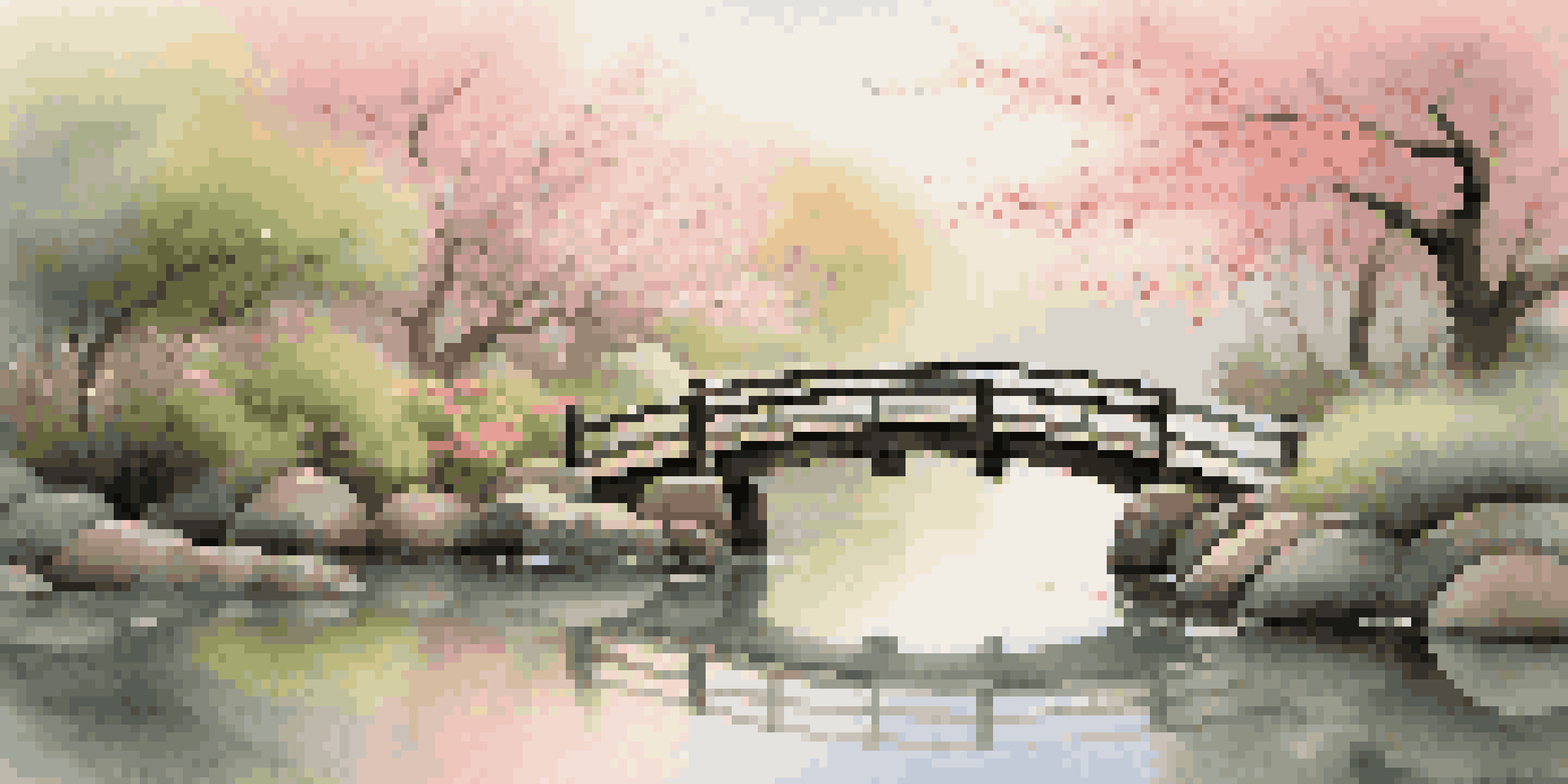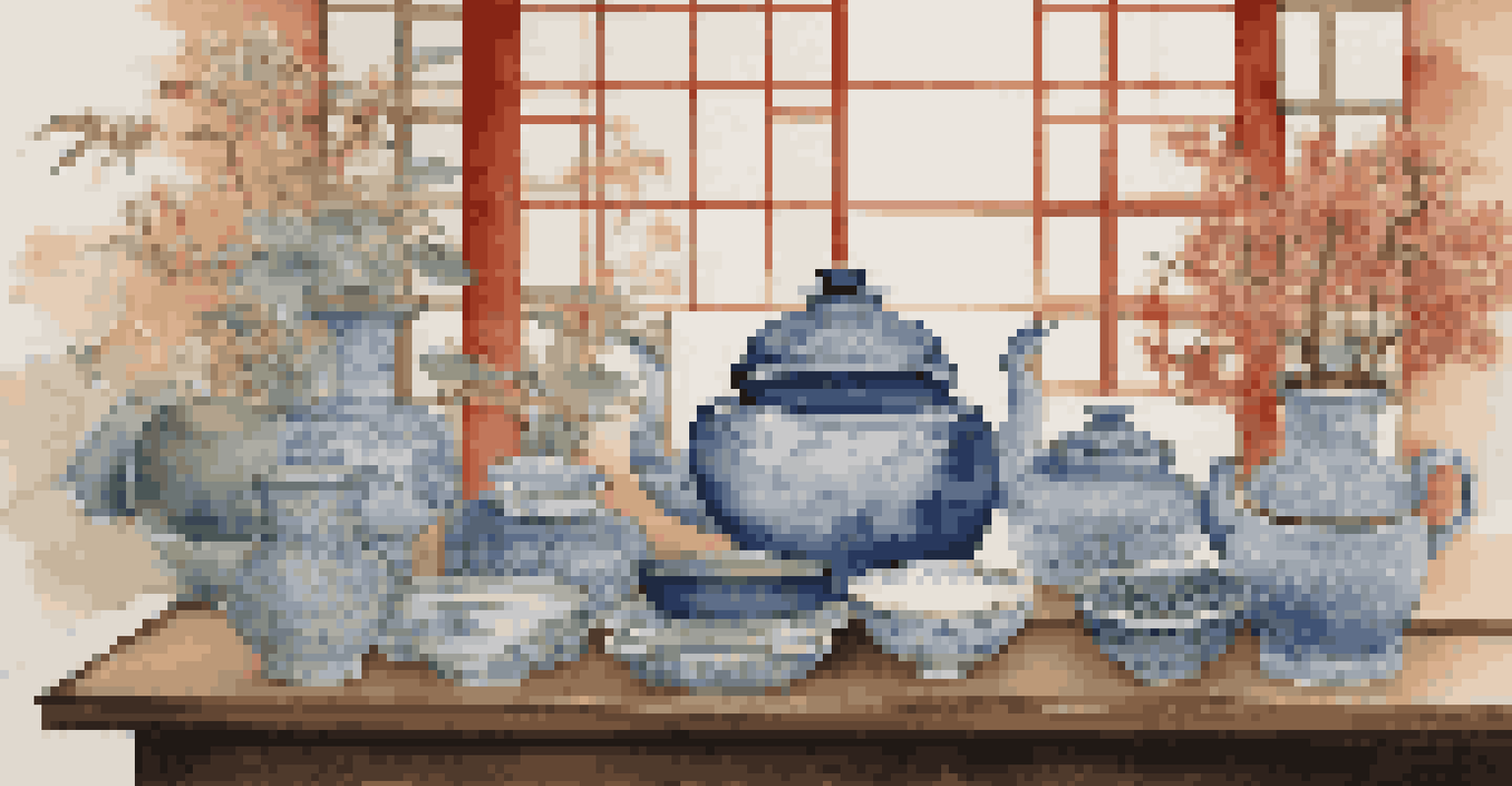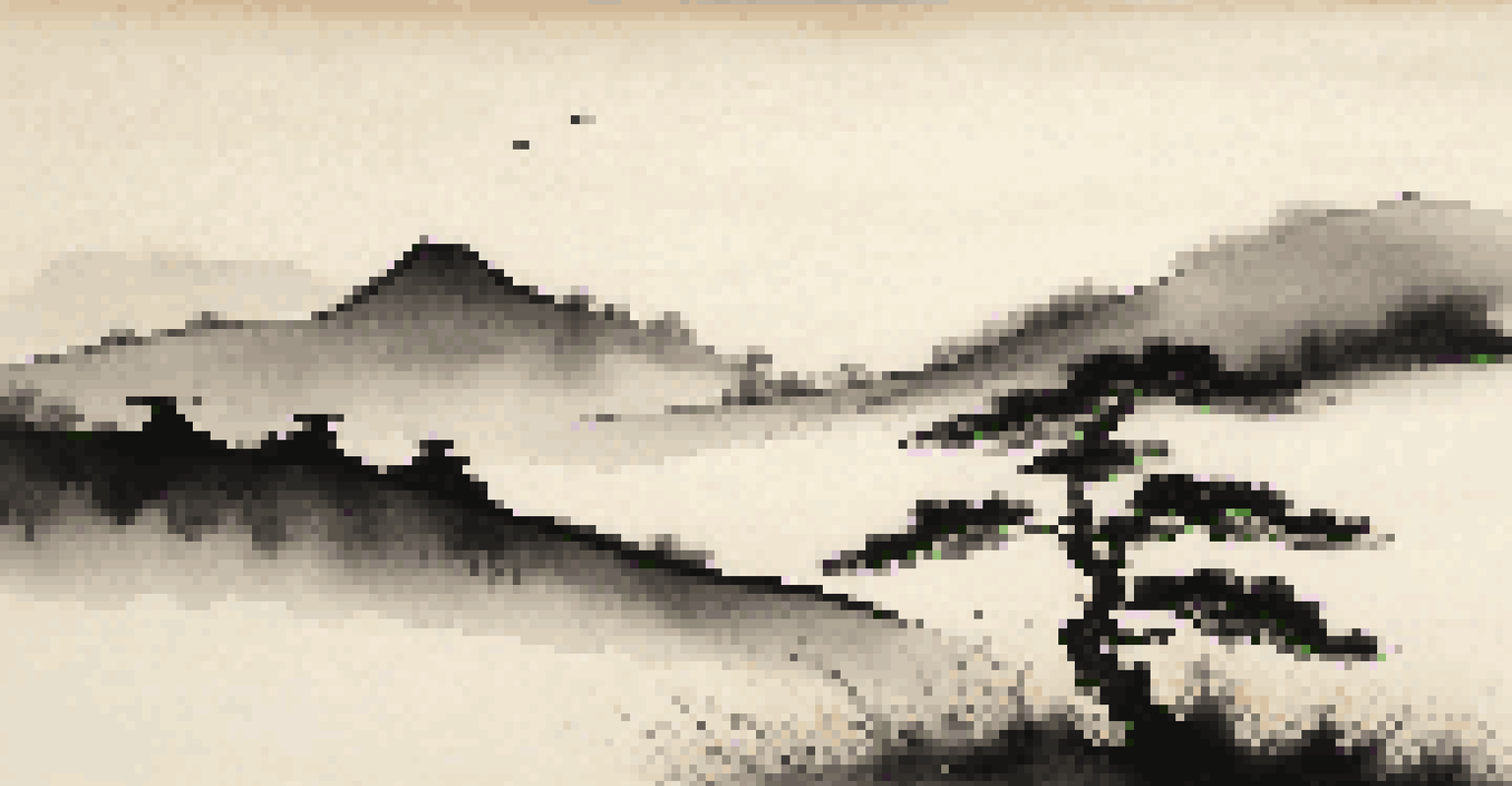Exploring the Influence of Japanese Art on Western Aesthetics

The Roots of Japanese Art: A Brief Overview
Japanese art, with its deep historical roots, encompasses various forms such as painting, ceramics, and textiles. Each of these art forms carries cultural significance, often intertwined with Japan's spiritual and philosophical beliefs. For example, traditional ink painting, known as 'sumi-e,' emphasizes simplicity and the beauty of nature, reflecting the Japanese concept of 'wabi-sabi,' or the beauty in imperfection.
The beauty of Japanese art lies in its ability to capture the essence of nature and the fleeting moments of life.
These artistic philosophies emerged from centuries of tradition, each influenced by nature, religion, and daily life in Japan. As Western artists began to encounter Japanese art during the 19th century, they found not just a new aesthetic but a different way of seeing the world. This intersection of cultures would lay the groundwork for a transformative artistic exchange.
Understanding the roots of Japanese art provides a foundation for appreciating its influence on Western aesthetics. By examining its principles, we can see how these ideas began to seep into Western thought, ultimately reshaping artistic practices across the globe.
The Arrival of Japonisme in the West
Japonisme, a term that describes the influence of Japanese art on Western culture, began gaining traction in the mid-19th century. As Japan opened its doors to the West, artworks such as woodblock prints and textiles flooded European markets, captivating artists and collectors alike. These pieces introduced new techniques and perspectives that would invigorate the stagnant art scene in Europe.

Artists like Vincent van Gogh and Claude Monet were particularly enamored with Japanese aesthetics, often incorporating elements such as bold colors, flat patterns, and asymmetrical compositions into their work. Van Gogh famously collected ukiyo-e prints, using their vibrant colors and unique perspectives to inspire his own masterpieces. This fusion of styles created a new visual language that broke away from traditional Western norms.
Japonisme Transformed Western Art
The arrival of Japanese art in the West inspired artists to embrace new techniques and aesthetics, leading to a significant shift in creative expression.
The impact of Japonisme extended beyond just visual art; it influenced fashion, interior design, and even architecture. The fascination with Japanese culture sparked a broader interest that would lead to a lasting legacy in Western aesthetics, encouraging a more fluid and diverse understanding of artistic expression.
Key Artists Influenced by Japanese Art
Several prominent Western artists were deeply influenced by Japanese art, and their works reflect this cross-cultural exchange. For instance, Edgar Degas's use of unusual angles and cropping in his ballet paintings was inspired by the perspective found in Japanese prints. This approach not only transformed how he depicted movement but also challenged traditional compositional techniques.
Art is the most beautiful of all lies; it is a reflection of our deepest truths.
Another notable example is Mary Cassatt, who incorporated Japanese elements into her depictions of domestic life, often featuring women in intimate settings. Her use of color and composition mirrors the simplicity and elegance found in Japanese art, highlighting the emotional depth of her subjects. This melding of styles allowed her to create a unique voice that resonated with audiences.
These artists exemplify how Japanese aesthetics encouraged Western artists to break free from conventional boundaries. By embracing new perspectives and techniques, they contributed to the evolution of modern art, demonstrating the power of cultural exchange.
The Role of Nature in Japanese and Western Art
Nature has always played a significant role in both Japanese and Western art, yet the ways in which they interpret and represent it can differ greatly. In Japanese art, nature is often depicted with a sense of harmony and balance, reflecting the belief that humans are an integral part of the natural world. This can be seen in traditional landscape paintings that celebrate the beauty of the seasons and the ephemeral nature of life.
In contrast, Western art historically focused on nature as a backdrop for human narratives, often prioritizing realism and grandeur. However, the introduction of Japanese art encouraged Western artists to explore new ways of depicting nature, emphasizing simplicity and abstraction. This shift can be observed in the Impressionist movement, where artists like Monet captured fleeting moments in nature with a newfound sensitivity.
Nature's Role in Artistic Traditions
Both Japanese and Western art interpret nature differently, with Japanese art emphasizing harmony and balance while Western art often uses nature as a narrative backdrop.
This shared appreciation for nature has fostered a deeper connection between these two artistic traditions. By blending the philosophies of both cultures, artists have created works that resonate on multiple levels, inviting viewers to reflect on their relationship with the world around them.
The Aesthetic of Minimalism: A Shared Philosophy
Minimalism, characterized by simplicity and the reduction of form, finds common ground in both Japanese aesthetics and modern Western art. In Japanese culture, this principle is evident in practices such as Zen Buddhism, where the idea of 'less is more' prevails. The beauty of a single flower or an empty space speaks volumes, encouraging contemplation and mindfulness.
In the West, minimalism emerged as a response to the complexity of modern life, pushing artists to strip away unnecessary elements to reveal the essence of their work. Artists like Donald Judd and Agnes Martin embraced this philosophy, creating pieces that echo the simplicity found in Japanese art. Their works invite the viewer to engage with the piece on a deeper level, akin to the meditative qualities of Japanese design.
The overlapping themes of minimalism in both traditions highlight a universal desire for clarity and tranquility in art. This shared aesthetic not only enriches the dialogue between cultures but also fosters a greater appreciation for the beauty of simplicity.
Japanese Patterns and Their Impact on Western Design
Japanese patterns, such as those found in kimono fabrics and ceramics, have significantly influenced Western design. The intricate motifs and vibrant colors often convey stories or cultural significance, sparking interest among Western designers seeking inspiration. This interest led to the incorporation of these patterns into various art forms, from textiles to wallpapers and ceramics.
Artists like William Morris were particularly inspired by the fluidity and natural forms of Japanese designs. His work in the Arts and Crafts movement embraced these elements, promoting a return to handmade craftsmanship and organic aesthetics. By blending traditional Japanese patterns with Western sensibilities, Morris and his contemporaries created a unique style that celebrated both cultures.
Minimalism Unites Cultural Aesthetics
The principle of minimalism, prevalent in both Japanese and modern Western art, highlights a shared philosophy of simplicity and mindfulness.
This synergy between Japanese patterns and Western design illustrates how cultural exchange can lead to innovative artistic expressions. The continued popularity of these patterns today demonstrates their timeless appeal and the enduring legacy of Japanese art in Western aesthetics.
The Lasting Legacy of Japanese Art on Global Aesthetics
The influence of Japanese art on Western aesthetics has created a lasting legacy that continues to shape artistic practices worldwide. From Impressionism to contemporary art, elements of Japanese aesthetics can be found in various forms, encouraging artists to explore new ideas and techniques. This ongoing dialogue between cultures fosters creativity and innovation, allowing art to evolve continuously.
Moreover, the appreciation for Japanese art has sparked interest in Asian cultures more broadly, encouraging a greater understanding of diverse artistic traditions. As global communication and travel become more accessible, artists draw inspiration from various sources, leading to a rich tapestry of cultural influences in the art world.

Ultimately, the impact of Japanese art on Western aesthetics serves as a reminder of the interconnectedness of human expression. By embracing the beauty found in different cultures, we can cultivate a more inclusive and enriched artistic landscape that celebrates our shared humanity.